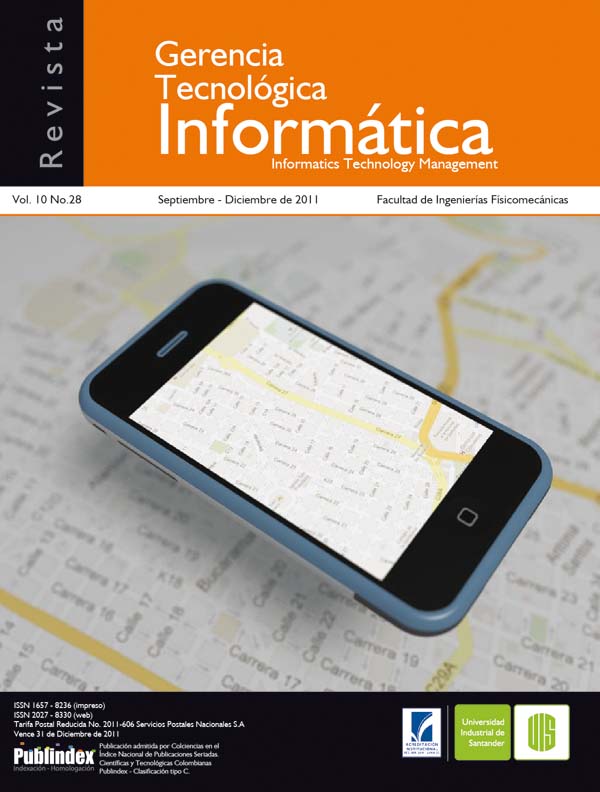CONTROL DIFUSO BASADO EN MICROCONTROLADOR PARA LA PRODUCCIÓN DE BIOGÁS EN DIGESTIÓN ANAEROBIA TIPO BATCH DE FRACCIÓN ORGÁNICA DE RESIDUOS SÓLIDOS
Published 2012-09-23
How to Cite
Abstract
RESUMEN ANALITICO
El manejo de los residuos sólidos generados por la población se convierte en un factor relevante por su impacto social y ambiental. Un manejo inadecuado de los mismos provoca entre otros aspectos enfermedades, contaminación de fuentes hídricas, del suelo y del aire por solo mencionar algunos. El biogás contiene un alto porcentaje en metano, CH4 (entre 50-70%), por lo que es susceptible de un aprovechamiento energético mediante su combustión en motores, en turbinas o en calderas, bien sólo o mezclado con otro combustible. Por lo anterior se plantea el desarrollo de este trabajo de investigación, en busca de aportar un conocimiento más en el campo de la digestión anaeróbica como alternativa energética, pues en Colombia este tipo de investigaciones no ha sido ampliamente realizado. Además, se incorpora elementos tecnológicos tales como los microcontroladores, los cuales se usaran como dispositivo controlador primario si se piensa en un sistema de desarrollo a bajo costo.
PALABRAS CLAVES: Biogás, Control Difuso, Microcontrolador, Digestión Anaerobia
MICROCONTROLLER-BASED FUZZY CONTROL FOR BIOGAS PRODUCTION IN BATCH ANAEROBIC DIGESTION OF SOLID WASTE ORGANIC FRACTION
ANALYTICAL SUMMARY
The solid waste management generated by the citizen population becomes an important social factor and environmental impact. Improper handling of solid waste cause diseases, water, soil and air pollution. Biogas contains a high methane percentage CH4 (50-70%), making it susceptible to recovery energy through engines combustion, turbines or boilers, alone or mixed with other fuel. The proposes the development of this research, seeking to provide more background information on the field of anaerobic digestion as an alternative energy in Colombia because such research has not been widely performed. Also incorporate technological elements such as microcontrollers, which were used as primary control device a low-cost development.
KEYWORDS: Biogas, Fuzzy Control, Microcontroller, Anaerobic Digestion
Downloads
References
- BOUALLAGI H. Effect of Temperature of the performance of an Anaerobic Tubular reactor treating fruit and vegetal waste. Process Biochemistry, Elsevier Science Ltda. 2003.
- BOUSKOVA, A. Strategies for Changing Temperature from Mesophilic to Thermophilic conditions in Anaerobic CSTR reactors Treating Sewage Sludge. Water Research. Elsevier Science Ltda 2005.
- CHARLES, W. Effect of Pre-Aeration and Inoculum on the Start-Up of Batch thermophilic anaerobic digestion of municipal solid waste. Bioresource Technology, Elsevier Science Ltda. 2008.
- CONPES DOCUMENTO 3530. Lineamientos y Estrategias para Fortalecer el Servicio Público de Aseo en el Marco de la Gestión Integral de Residuos Sólidos. Consejo Nacional de Política Económica y Social. República de Colombia. Departamento Nacional de Planeación. 23 de Junio de 2008.
- DAREIOTI, Margarita. Biogas Production from Anaerobic co-digestion of agroindustrial wastewater under thermophilic conditions in a two-stage process. Elsevier Science Ltda. 2009.
- DS18S20 High Precision 1-Wire Digital Thermometer DataSheet. Dallas Semiconductor, 2008. Disponible en internet: http://pdfserv. maxim-ic.com/en/ds/DS18S20.pdf.
- DUARTE, Oscar G. UNFUZZY: Fuzzy Logic System analysis, design, simulation and implementation software. 1998. Disponible en internet: http:// www.eusflat.org/publications/proceedings/ EUSFLAT-ESTYLF_1999/papers/251-duarte-2.pdf.
- Instituto para la Diversificación y Ahorro de la Energía IDAE. Biomasa: Digestores Anaerobios. Ministerio de Industria, Turismo y Comercio. Gobierno de España. ISBN: 978-84-96680-21-0. Madrid Octubre de 2007.
- FERNÁNDEZ, Alejandro y SANCHEZ, Mayra. Guía para la Gestión Integral de los Residuos Sólidos Urbanos. Dirección Provincial de Servicios Comunales de la Ciudad de La Habana. Organización de las Naciones Unidas para el Desarrollo Industrial. 2007. Disponible en internet: http://www.unido.org/fileadmin/ import/72852_Gua_Gestin_Integral_de_RSU.pdf.
- FORSTER, T. The Effect of Temperature variations on the Performance of Mesophilic and Thermophilic Anaerobic Filter Treating a Simulated Papermill Wastewater. Process Biochemistry, Elsevier Science Ltda 2002.
- GUEVARA, Antonio. Fundamentos Básicos para el Diseño de Biodigestores Anaeróbicos Rurales: Producción de Gas y Saneamiento de Efluentes. Centro Panamericano de Ingeniería Sanitaria y Ciencias del Ambiente. Lima. 1996. Disponible en internet: http://www.bvsde.paho.org/bvsacd/ scan2/031042/031042.pdf.
- HUZMEZAN, Mihai. Advanced Control of Batch Reactor Temperature. Proceedings of the American Conference. IEEE Xplore. 2002.
- KANAGARAJ, N. An Embedded Fuzzy Controller for Real Time Pressure Control. IEEE Xplore. 2006.
- KOMEMOTO, K. Effect of temperature on VFA’s and biogas production in anaerobic solubilization of food waste, published by Elsevier Ltd, 2009.
- KON KIM, Jung. Effects of Temperature and Hydraulic Retention Time on Anaerobic Digestion of Food Waste, Journal of Bioscience and Bioengineering, 2006.
- LINDORFER, H. New data on temperature optimum and temperature changes in energy crop digesters, published by Elsevier Ltd, 2008.
- MAN-CHANG, Wu. Influence of temperature fluctuation on thermophilic anaerobic digestion of municipal organic solid waste, Journal of Zhejiang University SCIENCE B, 2005.
- MANDAL, T. Determination of the Quality of Biogas by Flame Temperature Measurement. Energy Conversion & Management, Elsevier Science Ltda. 1999.
- Miniature Infrared Gas Sensor for Monitoring CO2 y CH4 up to 100% Vol. e2v Technologies. 2009. Disponible en internet: http://www.e2v. com/assets/media/files/sensors_datasheets/IR/ IR15TT-R.pdf.
- NGUYEN, Hung T. A First Course in Fuzzy and Neural Control. Editorial Chapman & Hall/CRC. Chapter 3: Fuzzy Logic for Control. Pág. 87-132. 2003.
- Signal Processing for Infrared Gas Sensors. e2v Technologies. 2007. Disponible en internet: http://www.e2v.com/assets/media/files/sensors_ datasheets/IR/infrared_an2.pdf.
- VAN LIER, Jules. Effect of Temperature on the Anaerobic Thermophilic conversion of Volatile Fatty Acids by Dispersed and Granular Sludge. Elsevier Science Ltda, 1995.
- VINDIS, P. Biogas Production with the use of mini digester. Journal of Achievements in Materials and Manufacturing Engineering. Volume 28.
